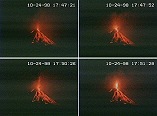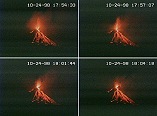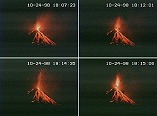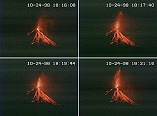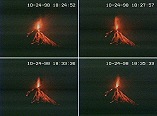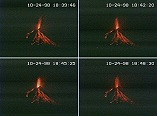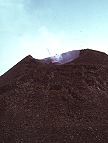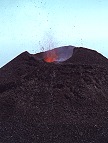Etna Current Activity [ Etna Home Page | Italian volcanoes map | Main Index | Home Page ]
Etna Decade Volcano, Sicily, Italy
Updates October 1998
The most recent updates
Etna news archive
28 October 1998
SE Crater, 28 October 1998

Two images taken by the Etna telecamera on 28 October 1998. Lava flows erupted from SE Crater (the steep cone at right) show in a black color, contrasting neatly with the freshly fallen snow in the left frame while the right frame was taken during the afternoon after much of the snow had melted.

|
Since early Sunday (25 October) morning, SE Crater has remained completely quiet. For the first time since the most recent eruptive episode on 24 October, the summit area was well visible today, allowing perfect views of the SE Crater cone with the black 25 October lava flows contrasting against freshly fallen snow (see telecamera images at left). If the crater maintains the behavior of the past seven weeks, then this quiet may continue until late Friday or Saturday, followed by the resumption of mild Strombolian activity from the intracrater cone. This activity would herald by about 24 hours the onset of a new paroxysmal eruptive episode which is most likely to occur on Sunday (1 November), possibly during daylight.
Like the preceding episoded, the 24 October eruptive episode was preceded by about 24 hours by weak Strombolian activity that was observed by two German visitors the evening of 23 October. The paroxysmal event itself lasted only a few hours but was very intense, with near continuous lava fountaining between shortly before 1900 h and shortly after 2100 h (local time - GMT+2). The lava flows on the southern flank came close to the tourist lookout at a fumarolic area in lavas erupted in September 1989 (about 0.5 km north of the Torre del Filosofo mountain hut) and then turned southeast towards Valle del Bove, reaching about 1 km in maximum length. The southwestern lava flow did not extend beyond the base of the SE Crater cone. By 2300 h all activity was over, but a brief episode of Strombolian activity occurred at around 0200 h the next morning.
Morphological changes caused by the 24 October episode appear to be limited to some lateral growth of the intracrater cone which now fills most of the former depression of the SE Crater, and filling by lava of the "moat" around the intracrater cone.
25 October 1998
SE Crater has produced its ninth eruptive episode in six weeks (that is, since 15 September) on the evening of Satuday 24 October. This episode occurred almost precisely one week after the previous eruptive event, confirming a linear trend in time, with intervals between eruptive episodes increasing by one day from one interval to the next. This pattern was revealed by scientists of the Istituto Internazionale di Vulcanologia in Catania and seems to work fine for the moment; however, the outcome of this particular eruptive behavior is not foreseeable.
Activity began to intensify at around 1700 h (local time - GMT+2) and was at its climax between 1900 and 2100 when Strombolian bursts jetted hundreds of meters above the summit of the erupting intracrater cone. At times several vents appeared to be active. The main lava flow issued from below the southern lip of the erupting vent, flowing in a narrow channel to the base of the intracrater cone where it bifurcated into at least five lobes that spilled down the southern flank of the SE Crater cone. As of 2100 h, these active lobes had reached the base of the cone, and movement appeared to be slowing. Another lava flow moved down the western side of the intracrater cone, ponded at its base and then spilled down the southwestern side of the SE Crater cone.
This morning (Sunday 25 October), weather conditions at Etna's summit are poor, and SE Crater is mostly hidden behind the dense gas plume issuing from Bocca Nuova, but a few glimpses reveal that no significant morphological changes have occurred at the crater.
If SE Crater maintains this eruptive behavior, the next eruptive episode should be expected to occur next Sunday (1 November). Such a forecast is based on a statistic approach and needs to be corroborated by other precursory phenomena such as volcanic tremor and increasing Strombolian activity.
19 October 1998
SE Crater, 17-18 October 1998
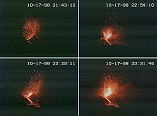
Impressive series of images captured from the Etna telecamera, between 2345 h on 17 October and 0134 h on the 18th (local time), showing initial stage of the eigth eruptive episode at SE Crater in the current eruptive period. Telecamera is zoomed on the summit of the intracrater cone that is the site of vigorous Strombolian bursts and lava splashing. Lava is overflowing from the active vent (thin oblique line below fountain in top left frame), reaches the flat area at the base of the intracrater cone and bifurcates (top right and bottom left frames), and a lava lobe spills over the rim of the old SE Crater (bottom left and right). Note increasing vigor of the fountain.

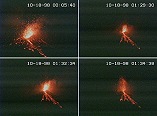
Continuation of the series 17-18 October 1998. These frames were captured between 0208 and 0337 h local time on 18 October. Top left is still zoomed on the intracrater cone and shows lava spilling down the south-southeastern flank of the SE Crater cone in several lobes. The remaining three frames are wider angle shots showing the whole of SE Crater and flows extending down the outer flanks of its cone, with vigorous lava fountaining at the summit of the intracrater cone.

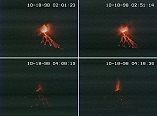
Declining stage of the 17-18 October 1998 eruptive episode, taken between 0404 h and 0621 h local time on the 18th. Top right frame shows full extent of lava flows on the southern and south-southeastern flanks of the SE Crater cone, and additional flows on the eastern flank. The bottom frames show yet another flow moving down the western side of the intracrater cone, but overall activity is much reduced, and most of the lava is stagnating and losing incandescence.

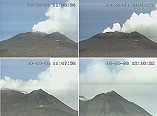
SE Crater before (top left) and after the 17-18 October 1998 eruptive episode. No significant morphological changes are evident, but the intracrater cone has grown slightly, and new lava flows have been emplaced on many sides of the SE Crater cone. Bottom frames are zooms on the SE Crater (left) and on the intracrater cone (right).

SE Crater, 11-12 October 1998
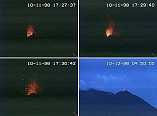
These images captured from the Etna telecamera are of the seventh eruptive episode from SE Crater, during the night of 11-12 October 1998. The first three frames show intense Strombolian activity and a small lava flow on the eastern (right) flank during the initial phase of the episode; the last image was captured at dawn and shows declining activity.

|
Strombolian activity at SE Crater resumed on the evening of 16 October, after three days of no eruptive activity from this crater. According to Marco Fulle (Trieste Astronomical Observatory) who witnessed the resumption of activity, there were first some high-pressure gas emissions during the late afternoon, without the ejection of pyroclastics. Strombolian activity had initiated sometime before 19:00 h (local time = GMT+2). This activity presumably continued and intensified through the afternoon of the following day, heralding the eigth episode of intense lava jetting and formation of a lava flow since 15 September, precisely six days after the previous, and very similar, episode from the same crater. Remote observation with binoculars from Sant'Agata li Battiati, a village some 5 km north of Catania, by Giovanni Sturiale of the Istituto di Geologia e Geofisica (University of Catania) during the night of 17-18 October revealed that the intracrater cone fractured on its southern side and lava issued from the fracture, overflowing onto the southern side of the SE Crater cone. While Strombolian activity from the summit vent of the intracrater cone culminated in about nine hours of spectacular Strombolian activity with jets several hundred meters high, the new lava flow advanced in up to five lobes a few hundred m downslope, slowing at the base of the SE Crater cone. Further flows spilled down the eastern and western sides of the cone (see the telecamera images at left). According to Sturiale, the most intense activity occurred around 03:00 h; the episode ended at around 06:30, and little activity has occurred thereafter.
Morphologic changes to the intracrater cone appar to be minor. There has been some change in the outline of the intracrater cone whose highest point is still on the southeastern rim of its about 20 m-wide crater. The recent eruptive activity at the crater have caused impressive growth of the intracrater cone which has merged with the northern outer flank of the pre-1997 SE Crater cone; especially when viewed from southeast and east it is a most prominent feature, but now it is even well visible from the southwestern base of Etna for the first time. The summit of the intracrater cone is consevatively estimated to stand at 3220 m, some 30-40 m higher than the highest pre-1997 rim of SE Crater.
Based on the fairly regular behavior of the crater in the past five weeks, a new eruptive episode may be expected within about 6-7 days after the previous one, possibly on Saturday 24 October.
Activity in the Bocca Nuova and in the Voragine appears to have continued without notable changes, but an increase in the vigor of the ejections of the northwestern vent in Bocca Nuova was noted by Marco Fulle on 15-16 October. Explosions from that site ejected bombs onto the northwestern and northern rims of the crater which were littered with fresh, and large (up to 1.5 m long) black bombs.
16 October 1998
Since its most recent eruptive episode on 11-12 October which lasted about 6 hours and was followed by declining Strombolian activity on the morning of the 12th, SE Crater has remained quiet, and no morphological changes have occurred at the intracrater cone which still has its highest point on the southern or southeastern side. Marco Fulle has been at the summit craters on several occasions during the past week and reported "zero activity" at SE Crater on Tuesday, 13 October. Another eruptive episode will probably occur during the next two or three days, a forecast also made by seismologist Eugenio Privitera of the Istituto Internazionale di Vulcanologia in the 13 October issue of the newspaper "La Sicilia" based on the behavior of SE Crater since its reawakening on 15 September (see previous update).
According to Marco Fulle, during his observations on 12 and 13 October, there was ongoing eruptive activity in the Bocca Nuova and in the Voragine. He remarked about the almost complete lack of noise during the eruptions from the southwestern vent in the Voragine which ejected abundant bombs of which many fell into the Bocca Nuova.
13 October 1998
The most recent episode of lava fountaining and lava emission of SE Crater during the night of 11-12 October was the seventh such event since the reawakening of the crater on 15 September, as reported by scientists of the Istituto Internazionale di Vulcanologia (IIV) who were cited in the Catania-based newspaper "La Sicilia". A lava flow extended about 1 km downslope, similar to that of the previous episode that occurred six days earlier. The episodic behavior of the crater may well continue although the outcome of this new phase of activity is not clear. It is well remembered among scientists studying Etna that the same crater displayed a series of spectacular paroxysmal episodes in September 1989 which marked the uprise of a voluminous batch of fresh, gas-rich magma and culminated in a flank eruption in Valle del Leone (the upper northwestern part of Valle del Bove). That eruption was accompanied by the formation of a (fortunately) non-eruptive fracture system that extended down the southwestern flank to about 1600 m elevation, uncomfortably close to one of the most densely populated areas on Etna. The present eruptive episodes at the SE Crater, however, are of much smaller magnitude and occur at greater intervals, and there is no geophysical evidence that magma is intruding at shallow levels into the fracture systems that radiate away from the central conduit system of the volcano.
In an interview in the newspaper "La Sicilia", Eugenio Privitera of the IIV predicted that the next eruptive episode from the SE Crater may occur 5-7 days after the previous one, that is, between Friday 16 October and Sunday 18 October. However, he told the interviewer, "we need to be very cautious" and the forecast was based on a probabilistic approach only.
Today the volcano is shrouded in clouds again, preventing any view of the summit areas.
12 October 1998
SE Crater, 12 October 1998
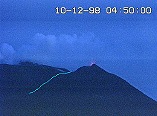
Image of the Etna telecamera (maintained by the Istituto Internazionale di Vulcanologia) taken this morning at shortly before 07:00 h (local time), showing a zoom on SE Crater and its active intracrater cone. Note the pointed outline of the southern or southeastern crater rim on the intracrater cone, and growth of the cone due to the vigorous activity initiated the evening before. The outline of the western slope is marked by a blue line to distinguish it from the main summit cone of Etna which stands behind it.

|
Vigorous eruptive activity has resumed on the evening of Sunday (11 October) at SE Crater which had shown only low levels of activity during the preceding days. The renewed activity consisted of specacular lava fountains and a lava flow that extended about 700 m downslope adjacent to the 5 October flow (that is, eastward), both of which were plainly visible from towns along the eastern coast of Sicily, as weather conditions improved. Strombolian activity at the intracrater cone of SE Crater continued throughout this morning. In contrast to the more violent reawakening of SE Crater on 15 September, this event has apparently caused little destruction of the intracrater cone which instead looks larger than before, with a high pointed summit on the southern or southeastern crater rim. The latest report about Etna's summit activity (kindly submitted by Marco Fulle) indicates that low-level activity persisted through Friday (10 October) evening, at the Voragine, Bocca Nuova and SE Crater.
The activity of SE Crater since 15 September which may be characterized as the second phase in the current eruptive period (initiated almost two years ago at SE Crater while eruptions at Bocca Nuova and NE Crater started in mid-1995). Activity is now more sporadic and fluctuates between periods of relative calm or very low-level activity that may last up to several days, and episodes of very intense Strombolian activity that may culminate in true lava fountains and short-lived, rapid effusion of lava flows, and last one to two days. This change in behavior does not seem to be significant in terms of an imminent major (flank) eruption, but Etna's long-lived summit eruption continues.
10 October 1998
Map of Etna's summit craters
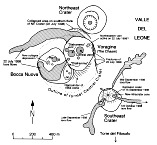
Updated sketch map of Etna's summit craters showing features frequently mentioned in the updates, and approximate extent of recent lava flows as of 5 October 1998. Active vents are indicated as gray dots in the craters.

|
During the past few days, activity at SE Crater has gradually declined and no eruptions were visible at nightfall yesterday evening. There is no information about th activity in the Voragine and Bocca Nuova.
7 October 1998
Updates of the activity of Etna through the evening of 6 October were provided by Jürg Alean (Stromboli On-line) who stayed on Etna's summit until the late evening of 5 October and returned there on the afternoon of the following day.
Strombolian activity at SE Crater was quite intense on the evening of 5 October when lava began to spill down its eastern flank. This flow which was plainly visible in the night from numerous locations to the east and south of Etna eventually reached a length of about 1 km (according to local press sources) and is thus the longest lava flow erupted from SE Crater during the current eruptive period (initiated in 1996 at SE Crater). The lava was again very fluid for the flow reached its full length in few hours; it stagnated on the morning of 6 October and no lava effusion was observed through the evening of the day. Strombolian activity at the intracrater cone was much weaker than on the preceding day, but increased slightly during the evening. Jürg Alean reports that the inner conelet in the summit crater of the intracrater cone had collapsed, and there was a peculiar dome-shaped structure on the eastern or southeastern crater rim which had many incandescent cracks. Activity in the Voragine was reportedly stronger on 6 October, and it had increased as well at the southeastern vents in Bocca Nuova.
6 October 1998
Etna's four summit craters were visited yesterday (on 5 October) by a group including Boris Behncke and Giovanni Sturiale of the Istituto di Geologia e Geofisica (University of Catania), Marco Fulle, and Jürg Alean (Stromboli On-line) as well as others. Three of the craters remain active while NE Crater was limited to forceful gas emission from a 30 m-wide vent on the floor of its about 80 m-deep central pit.
Activity in the Voragine was limited to one vent in its SW part, corresponding to the location of the large "diaframma" vent active before the 22 July 1998 eruption. This vent which was about 100 m wide and tens of meters deep ejected bombs in near-continuous bursts, but all ejecta fell back into the vent. More vigorous bursts occurred every few minutes which sent bombs higher than the western crater rim. Four other vents in the Voragine were degassing quietly; these were the central vent (about 100 m in diameter), a vent close to the SW crater rim (some 50 m wide) and two vents each about 20 m wide, one on the southern side of the central vent, and the other sitting on the crest of the "diaframma". There is no evident alignment of vents within the crater, but a depression in the northeastern part of the Voragine which may have been a vent of the 22 July eruption and is now partly filled with more recent ejecta, lies in a NE-SW trending line with the central and the SW vent.
Within Bocca Nuova, both the northwestern and the southeastern vent areas produced Strombolian activity. At the former, two vents in the wetern part of the cone were the site of continuous minor bomb ejections culminating in fountains about 100 m high every 5-15 minutes. The central vent of this cone which had been the site of all eruptions in early-mid September was silent. Only very few bombs fell outside the crater, mainly on the western and northwestern rim, but abundant fresh-looking bombs indicated that stronger activity had occurred after the most recent rain on the summit (two days earlier). This activity was quite different from that observed a few weeks earlier when the northwestern vents produced mainly ash emissions probably caused by internal collapse. A circular collapse depression had formed in the southern part of the cone, the same area where subsidence had been most pronounced during the preceding period of subsidence (January-April 1998). Extensive fracturing of the lava flow that had entered the Bocca Nuova during the 22 July Voragine eruption indicated that minor subsidence had also affected a wider area. In contrast to the morphological changes at the northwestern vent, no significant modifications were evident at the southeastern vents where continuous Strombolian activity occurred from two closely spaced vents in the southern part of the elongate collapse depression formed in early 1998.
The most spectacular activity was occurring at the SE Crater which had apparently resumed its eruptive activity only the night before. Poor visibility had precluded observation for most days since 30 September when intense activity was rapidly building the intracrater cone and a new lava flow was spilling down the southwestern flank of the SE Crater cone. On the evening of 1 October, no incandescence was visible at the crater, and brief glimpses of the summit during the following days revealed that no further growth of the intracrater cone had occurred since 30 September. A group of Belgians encamped about 800 m south of SE Crater reported that on 4 October, the day before our summit visit, there was no eruptive activity at the crater, but they observed renewed activity during the night. (Usually reports by occasional visitors are to be taken with much caution, but this group is quite experienced with Etna, and their information appears accurate.)
During our observation period, Strombolian bursts occurred incessantly, hurling brightly incandescent bombs up to 200 m above the vent. The site of this activity was acould be well observed from the southeastern rim of the former Central Crater. A small conelet a few meters high that had grown around this vent was destroyed as powerful Strombolian explosions occurred around 1300 h (local time), and the active vent widened to 8-10 m diameter, with a low pyroclastic mound around it. Meter-sized lava blobs jetted continuously from the vent, rapidly filling the crater of the intracrater cone, and bombs were showered over most of the SE Crater and down its northern flank. Many explosions were caused by the bursting of magma bubbles, similar to those observed in June-August at the Voragine, but the magma at SE Crater appears to be more fluid. Explosion noises were much less intense than those of the Voragine.
Although the intracrater cone had grown significantly since the 19 September visit, it had not yet entirely filled the 15 September explosion crater whose rims were visible as "steps" in the slope of the cone, especially on its northern and southern sides. The late-September lava flow had apparently issued from the moat between the new intracrater cone and the south rim of the 15 September crater; from there it had spilled in two thin lobes across the southwestern crater floor and down the southwestern flank of the SE Crater cone. This lava was evidently much more fluid than lavas erupted during the previous eruptive period that ended in late July. On the other hand, the flow was very short-lived for it did not extend beyond the base of the SE Crater cone.
Among other observations made in the summit area was the discovery of a non-eruptive, north-south trending fracture about 30 cm wide on the southeastern flank of the main summit cone. No fumarolic emissions occurred from the fracture which was partly buried by slides of recent pyroclastics on the steep slope. This fracture may be the southward extension of a steaming fracture observed in mid-June on the southeastern rim of the former Central Crater, in an area of persistent fumarolic activity; that fracture was buried by the 22 July scoria deposit. It is not clear when this fracture system formed and what - if any - is its relationship with the impressive fractures formed on 22 July on the eastern and southeastern side of the Voragine.
The 5 October 1998 observations confirm that Etna continues to be in a stable state and that, in spite of the vigorous, and highly spectacular, activity of SE Crater, the levels of activity are now reasonably lower than during the period June-August 1998.
Page set up on 2 November 1998
Hosted by VolcanoDiscovery


